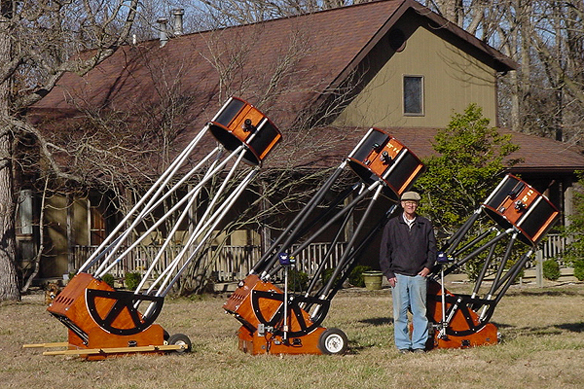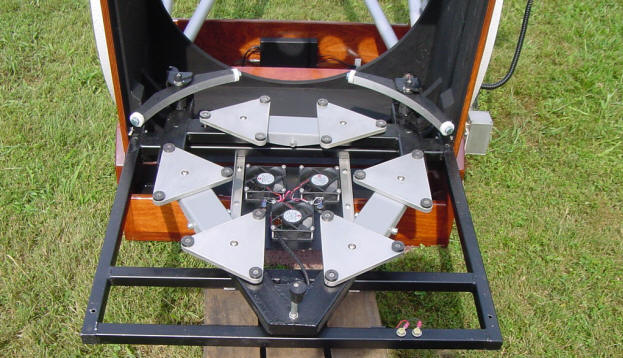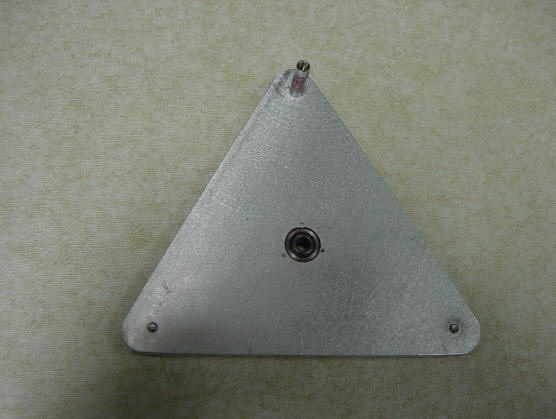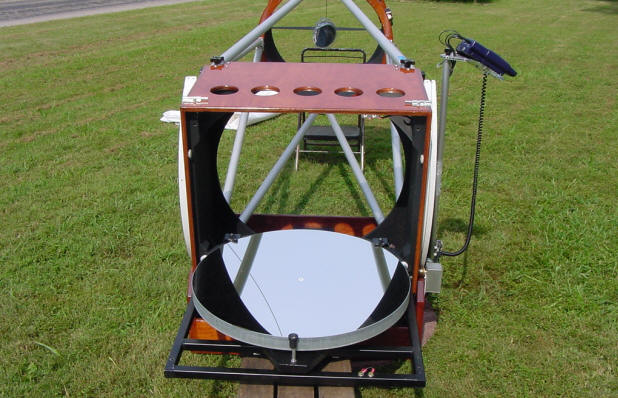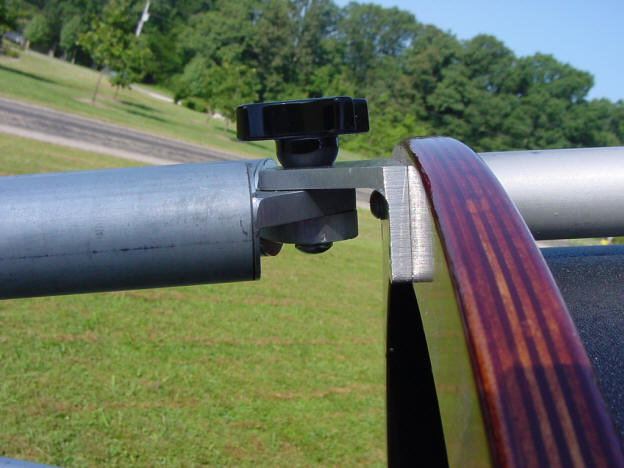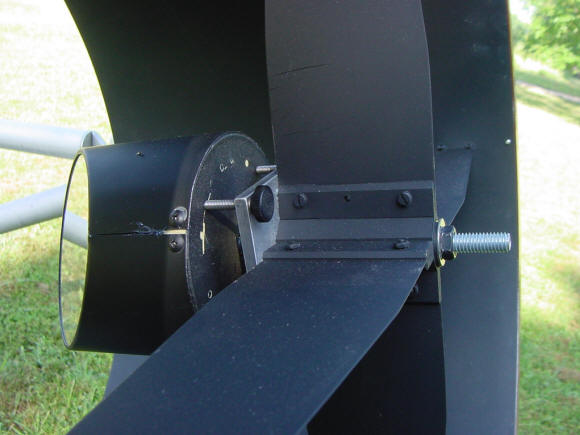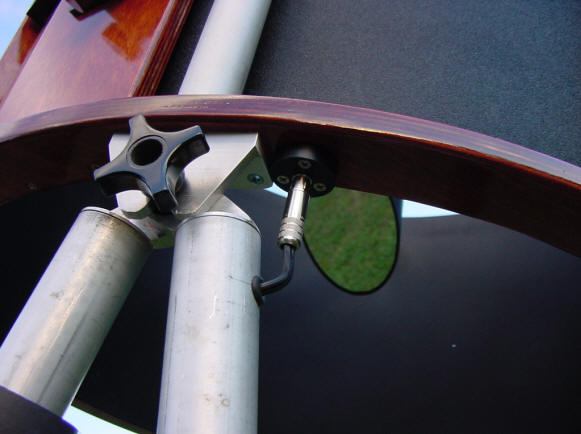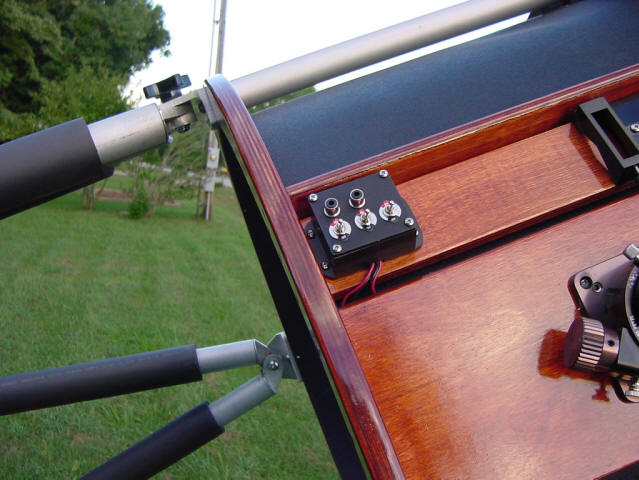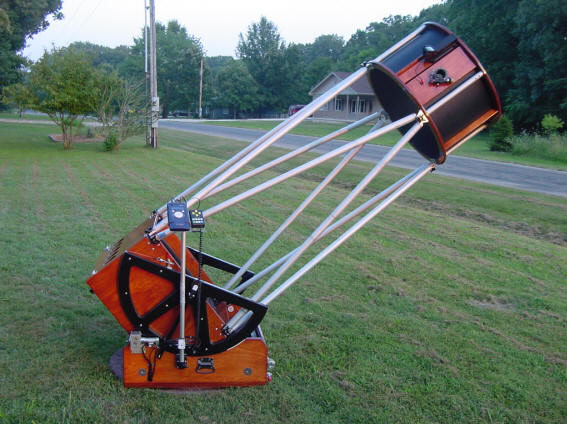|
The
Twenty Five
HOME Telescopes Mirror
Cells Custom
Projects Photos Contact
Side
by
side comparison of the Twenty Five and the Sweet Sixteen Telescopes.
The
assembled 25" f/4 is easily moved on the wheels which can be left on
during observing or removed in seconds.
The
Twenty-Five is available in (from left to right) an f/5, f/4, and now
the
"No Ladder" f/3 configuration. All feature Lockwood primary and
secondary mirrors.
The f/3 scope with Argo
Navis,
ServoCat, and Starlight SIPS coma corrector/focuser system. It features
a 1.7" thick Lockwood primary and matching 6" secondary. The eyepiece
height is 70" at zenith, but the remaining dimensions other than
overall height are the same as the F4 specifications listed below.
The Twenty
Five shares the
basic design concept of the sweet Sixteen, but has a number of new
features I wanted for this larger telescope.
Dimensions and weight:
Height at
zenith .......................................... 103"
Eyepiece height at
Zenith
......................... 95"
Rocker box
footprint..................................
31.5" square
Weight complete with
Servocat etc. ....... 288 pounds
The following
photographs
taken at various stages of the construction of this, the first of
three telescopes built, best illustrate the new
features. Please contact me if you have questions about the
construction or availability of the Twenty Five.

Rear view showing
the JP
Astrocraft 18-point mirror cell and the Mike Lockwood
1.7" thick primary optic. This is a tilt down / lift out type
cell which is secured by the four black knobs at the four corners of
the frame. The five round ventilation holes in both the front
and rear faces of the mirror box allow passive airflow across the front
surface of the mirror. These can be fitted with fans if additional
boundary layer cooling is desired.
Removing the four
knobs
allow the cell to tilt down for easier insertion or removal of
the Lockwood Primary. The cell also simply lifts out of it's "U" shaped
support brackets. This cell features spherical bearings at
the triangle supports and a 45 degree wiffletree edge support.
Bottom
view of the flotation triangle showing the mounted spherical bearing
and triangle positioning pin.
The
mirror installed.
Electrical
contacts at the upper right of the frame engage as the cell is closed
to provide power to the cell fans.
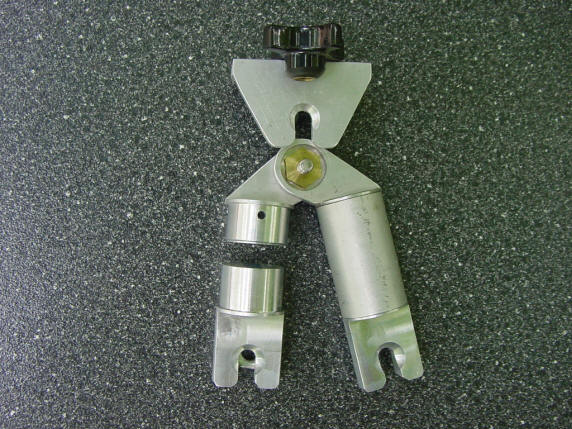
These are the parts
that
make up the truss system . The ball shaped recesses milled into the two
lower inserts and the upper cage mounting angle provide a positive
alignment system when the ball shaped end of the knob is tightened. The
two 1 1/2" poles end at a common point forming a true triangle
for optimum strength. The poles are connected by a brass tee
nut which provides both a bearing and a connection.
The spot faced recess in the right ear allows everything to clamp up
solid when tightened. This system allows fast easy assembly of the
telescope.
The
lower end of the truss showing how the lower insert fits over a 3/8"
stainless mounting stud in the 3" x 3" x 1/4" aluminum corner angle.
Side
view of the top showing how the knob draws all the parts tightly
together. The top ears on the poles are 3/8"-thick aluminum bar.
A massive 4-vane
spider
featuring a center hub milled from a 2" solid bar. Note how
the big hub has the square plate holding the four
collimation screws tightened securely to it. This
keeps the secondary mounting stud from bending under the weight of the
large secondary.
Power
to the upper cage is routed through a truss pole and plugged into a
junction block mounted on the bottom cage ring. Strut tubes
are located directly above the truss anchor for maximum rigidity.
A switch block
mounted on
the finder board distributes power to the anti-dew devices. The right
hand switch controls the Astrosystems secondary heater while the other
two provide switched junctions for finder and eyepiece heaters.
Even though the
assembled
scope weighs 288 lbs, the integral wheels allow me to move it out of
the shop to my observing site about 200' away. The wheels detach
quickly if desired . Slide bolts lock the mirror box to the rocker for
moving. Integral wheels are nice if you have facilities to store the
assembled telescope as it's over 8' high.
The rocker has inserts
to
attach wheelbarrow handles for loading into a vehicle. Normally,
however I will have a friend help me lift the lower assembly into my
van using the two handles on the rocker.
This
picture of the scope was taken just after I had mounted the ServoCat
and Cattail stalk.
HOME Telescopes Mirror
Cells Custom
Projects Photos Contact
|

